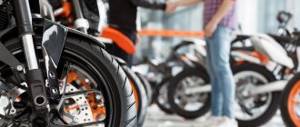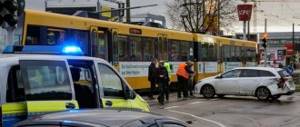Categories of rights to a forklift
Anyone wishing to legally operate loading equipment should decide on several issues:
- How and where are forklift licenses issued?
- What category of rights and rank are required to work on a vehicle?
Having dealt with organizational issues, decide on the choice of a specialized driving school, submit the documents and start classes so that in 2 - 3 months you will receive a category for driving a forklift.
Further, in the article: categories of rights and categories, a list of required documents, the procedure for registering and obtaining a new driver’s license.
The need to strictly classify existing auto-loading equipment is caused by the variety of types and functional features of vehicles.
Category types:
- A (I - IV) - control of certain types of “off-road vehicles” - ATVs, snowmobiles, warehouse loaders with a power of up to 4 kW;
- B - for wheeled and tracked vehicles with power: 4 - 25.7 kW;
- C— for wheeled vehicles 25.7 – 110.3 kW;
- D - for wheeled vehicles from 110.3 kW;
- E— for tracked loaders from 25.7 kW;
- F—for agricultural machinery.
Everyone who completes courses in the chosen specialty is issued a tractor driver's certificate marked: category-rank.
Explanations for obtaining a tractor driver's license
As the head of a training center, I regularly have to deal with facts when students, and what about students - business managers who send specialists to learn how to drive a particular vehicle, do not understand what kind of certificates they need for this. Meanwhile, this issue of ensuring labor safety at the enterprise is extremely important both for workers and for the managers themselves. Indeed, in the event of any incidents at the warehouse, an investigation is carried out, and driving a self-propelled vehicle of one category by a driver who has a tractor driver’s license of another is classified as driving without a license.
In such cases, both direct executors and managers (officials) who allowed the equipment to be controlled by unauthorized personnel are held accountable, and depending on the consequences it can be even criminal. Meanwhile, understanding the categories of self-propelled vehicles and the licenses required to operate them is quite simple. We will be helped in this by Resolution No. 796 of July 12, 1999 of the Government of the Russian Federation “On approval of the Rules for admission to driving self-propelled machines and issuing licenses for tractor driver (tractor operator)”, where the types of machines and the necessary certificates are sorted out.
So, a document that allows driving a self-propelled machine and is handed to the driver is called a tractor driver’s license. It contains entries about the following categories of equipment.
Category A – motor vehicles not intended for driving on public roads or having a maximum design speed of 50 km/h or less. It includes:
• I – off-road motor vehicles (ATVs and snowmobiles fall under this category);
• II – off-road vehicles, the permissible maximum weight of which does not exceed 3.5 thousand kg and the number of seats in which, in addition to the driver’s seat, does not exceed eight (this includes the so-called swamp vehicles - four-wheeled cars with two side-by-side seats side and, as a rule, with a body);
• III – off-road vehicles whose permissible maximum weight exceeds 3.5 thousand kg (except for those belonging to category A IV). An example of a vehicle in this category would be a mining dump truck or an all-terrain vehicle of the Ural-Polyarnik type;
• IV – off-road vehicles designed to transport passengers and having more than eight seats in addition to the driver’s seat (in particular, an apron bus, which is used at airports).
Category B - tracked and wheeled vehicles with an engine power of up to 25.7 kW, no matter what type - be it diesel, petrol or electric. It covers both mini-tractors and mini-excavators, as well as most electric forklifts. The most common special words are “tractor driver” and “electric forklift driver”.
For drivers of electric forklifts, a tractor driver's license with open category B and special O is sufficient, or, if the machine has a power of up to 4 kW, a certificate issued by a training center
Category C – wheeled vehicles with an engine power from 25.7 to 110.3 kW. This is perhaps the most popular category: it includes both most diesel forklifts and front-end loaders, ranging from their mini version - the Bobcat - to some Amkodor models. The most common special words are “excavator operator” and “tractor driver”. Special marks may be the same as in category C.
Category D – wheeled vehicles with an engine power exceeding 110.3 kW. Powerful front loaders of brands such as Dresta, Volvo, Caterpillar, etc., designed for reloading large-capacity sea containers, are representatives of this category. Special marks may be the same as in category C.
Category E – tracked vehicles with an engine power exceeding 25.7 kW. The most common are the special o and “tractor driver”.
Category F – self-propelled agricultural machines.
The clauses of the resolution determine what entries and marks are allowed to be made on the certificate:
5. In order to ensure control over the compliance of the work performed with the assigned qualifications, a restrictive or permissive entry about the availability of qualifications (qualifications) is made in the special marks column of the tractor driver (tractor operator) certificate.
6. If there is a permit mark (o, “C”, “D” and “E” in the tractor driver’s (tractor driver’s) license, no additional entries are required to perform work that corresponds to the tractor driver’s qualifications.
Car mechanics who use the ancient Rokhla hardly suspect that they must also be Category C tractor drivers.
What are special marks? The fact is that all tractor drivers, like any workers, are trained in educational institutions according to certain programs. There are training programs for tractor drivers, there are for excavator drivers, and there are for loader drivers. There are others, but these are the most common. It is believed that during the training, students acquire the knowledge and skills necessary to safely operate a loader, tractor or excavator. That is, it is not enough for the driver of a loader or stacker to have a license of the appropriate category: in order to be allowed to work, he also needs a corresponding special mark in the certificate. Paragraph “6” of the Rules states in which case it may not exist - if the driver has open categories B, C, D and E.
Is it possible not to study for 2.5 months (namely, this is the duration of training to become a tractor driver)? -Yes, I have. If you have forklifts with an engine power of up to 4 kW, you do not need a Gostekhnadzor license to drive them. It is enough to have a driver’s license for an electric forklift or stacker with a power of up to 4 kW. Training for this specialty takes less time and costs less. But such a certificate has one drawback: while holders of ordinary tractor driver’s licenses simply change them once every 10 years, then for drivers of loaders with a power of up to 4 kW, annual recertification is provided. It can be completed both at the training center and at the enterprise commission.
Is it necessary to have a separate license to drive a forklift with a power of up to 4 kW if the driver already has a category B license with a special license? -No, don't. After all, such a driver’s license says: “wheeled and tracked vehicles with an engine power of up to 25.7 kW.” There is no mention of equipment “from 4 kW” there. How to determine the power of an electric forklift, since it has an electric motor for the movement mechanism, and often more than one, an electric motor for the hydraulic system, which can be even more powerful than electric drive motors, and a separate electric power steering motor? By engine power or total power of the vehicle’s movement engines.
The engine power of these loaders is more than 150 hp. or 110.3 kW - therefore, to control them you need category D
So, we have decided on the necessary (but not sufficient) documents to work on a loader or stacker. Let's summarize.
For those who operate equipment with a power of up to 4 kW, a certificate issued by the training center is sufficient. Recertification – once a year.
If an employee operates an electric forklift with a power of more than 4 kW, but not more than 25.7 kW, then he must have a tractor driver’s license with an open category B and a special o. The certificate of completion of training courses requires a record of the assignment of 3rd category.
Category C tractor driver's license with special certificate
A candidate for diesel forklift driver must have a category C tractor driver license, 4th category and a special certificate. But only if the loader is no more powerful than 110.3 kW, and speaking in Russian - no more than 150 “horses”.
One more point: all warehouse workers who operate forklifts, electric pallet trucks and stackers (reach trucks) must have valid medical certificates. Those who have a tractor driver's license must have one like that of a car driver, with a note indicating that there are no contraindications for driving self-propelled machines. They must say: “fit to drive tractors and other self-propelled agricultural machines.” It should be explained to the staff that, when passing the driver’s commission, the employee can and must inform the commission about the category of “regular” driver’s license he has. Why go through a commission 10 times if the absence of medical contraindications to driving cars and motorcycles, as well as self-propelled vehicles, can be reflected in one medical certificate?
For workers operating equipment with a power of up to 4 kW, regular certificates issued at any clinic are also suitable. Personnel using forklifts, trolleys and stackers have certificates for the right to operate them and medical certificates - necessary, but far from sufficient conditions for safe work.
Rank
ETKS (Unified Tariff and Qualification Directory) is a document regulating the assignment of categories. The purpose of the document is to determine the level of planned work and assign categories based on the complexity of vehicle management and maintenance. The directory is also used when drawing up programs for training and retraining of personnel.
Classification of categories:
- 2 tracked and wagon loaders, devices for grabbing cargo during storage, transportation, loading (unloading), under the supervision of a qualified specialist.
- 3 - battery-powered vehicles and lifting mechanisms for loading and unloading operations of all types.
- 4 - 7 - tractors, wagon loaders, and other auto-loading mechanisms. The calculation and distribution of 4-7 digits is carried out in accordance with the power of the vehicle, from less to more powerful.
7th category - means the maximum level of qualification and the highest complexity of the vehicle. As a rule, these are powerful front loaders from 200 kW for serious loading and unloading work of large volumes.
Documents for front loader
Issuing rights to operate special equipment is the responsibility of Gostekhnadzor, the state organization that controls the use of self-propelled vehicles.
What category of license is needed for a front-end loader, and what is this vehicle?
A front loader is a self-propelled mechanism for lifting, grabbing and moving cargo, in particular bulk materials - it is at the same time an excavator, leveler, bulldozer, etc.
Classes and passing exams for permission to work on a front loader involve mastering the theoretical part and gaining practical skills when tested at training grounds.
ABOUT
Features of classes for working on a forklift:
- Course duration: 1.5 months.
- Mandatory exam after graduation.
- Issuance of a temporary certificate.
After completing the course completion document, the future driver will have to pass a duplicate exam at Gostekhnadzor and receive a full license with an open category.
How does the forklift driver exam work?
Exams are held on the territory of the training center of CPIA LLC, in the presence of an inspector from Gostekhnadzor. First you need to pass the theoretical part, then the on-site exam.
Thanks to high-quality training and a calm, friendly atmosphere during the exam, 95% of students pass the exam successfully the first time at the PREPARATION AND CERTIFICATION CENTER.
Diesel forklift
Diesel forklifts are vehicles for warehouses with an internal combustion engine. Diesel forklifts are designed for transporting goods inside warehouses.
The duration of training at a certified training center for diesel forklift drivers is 3 months. The training process is identical to the training course for front-end loaders - this is a theoretical part on knowledge of traffic rules and practical driving, on a race track, under the guidance of instructors, then passing tests to a representative of Gostekhnadzor and obtaining a license.
The license to drive a diesel forklift is valid for 10 years, after which the driver must undergo retraining, pass an exam and receive a new license.
A mandatory rule for drivers of diesel forklifts is annual recertification to ensure the required level of qualifications.
Who can receive
An applicant must be at least 18 years of age to obtain a forklift license. there are no contraindications regarding health status. The presence of contraindications is determined by a medical commission, which is mandatory for all applicants.
The student is also expected to have taken a driving course. This will be due to the fact that special equipment can move on public roads in the same way as other vehicles.
Individuals who plan to undergo not only training, but also re-certification, choosing work related to the operation of special equipment, apply to obtain rights.
How to train and obtain a license for a forklift:
Electric forklift
An electric forklift is a type of warehouse equipment with functionality similar to a diesel forklift.
Advantages of an electric forklift:
- ergonomics in maintenance and repair;
- quiet operation;
- environmental safety, the ability to use transport to work in “clean” rooms.
Electric warehouse forklifts run on AC batteries.
Licenses to operate electric forklifts are issued at certified driving schools. Course duration is 2 months. The course consists of theoretical and practical parts. Next, students take tests, receive temporary licenses and undergo an internship. He completes his studies with an exam at Gostekhnadzor. If successful, the electric forklift driver receives a permanent license (category BC) for a period of 10 years.
Features of the training course
Legal operation of loading and unloading equipment requires that the driver of the vehicle has an appropriate license indicating the category of approval. The category includes certain types of forklifts, differing in design and functional features.
Before starting training, the driver determines which vehicle he plans to work on and selects the appropriate course, after which it becomes possible to calculate the cost and duration of training.
General characteristics of the categories of rights to a forklift:
- Category B - low-power vehicles, weight up to 5 tons (mini-equipment).
- Category C - loaders with power: 25-110 kW.
- Category D - forklifts over 110 kW.
Training lasts from 1.5 to 3 months, depending on the complexity of the chosen category.
The legislation of the Russian Federation indicates a mandatory requirement for forklift drivers: to obtain a license, you must complete a training course at a certified center and pass an exam at Gostekhnadzor. Passing the theory is mandatory for drivers with a “clean” license, without open categories.
Everyone takes the practical driving test, regardless of whether or not they have a license. After passing the practical part of operating a forklift, examinees receive forms with the exam result.
The State Traffic Inspectorate does not issue licenses for special equipment, including forklifts. Issuing driver's licenses of this type is the direct responsibility of Gostekhnadzor.
Documents and registration
When enrolling in a forklift driver course, make sure that the selected center has a state license and a package of documents that allows you to conduct classes and issue temporary certificates for driving a vehicle.
After receiving a certificate of completion of the special course, the future driver is obliged to contact the local branch of Gostekhnadzor and provide documents for exchanging temporary licenses for permanent ones:
- Russian passport;
- temporary certificate;
- receipt of payment of the duty;
- photographs (3x4);
- health certificate;
- a copy of the exam form.
Having completed the documents at Gostekhnadzor and passed the final test, the driver will have to wait 7-10 days until a new type of certificate is issued for the forklift driver, after which he can legally begin work.
Cost of courses in Moscow
Full package
All documents on hand
Popular tariff - suitable when you need a specialty, for example, for employment.
- Issuance of scans within 1 day ⏱
- State-issued certificate of assignment of profession ✅
- State-issued certificate of assignment of work category ✅
- Extract from the training protocol
- A money back guarantee specified in the contract if the documents are not accepted by the employer❗️
- Free delivery ✈️
- Free consultation with managers on all issues ☎️
(1 day)
4,500 rub.
6,500 rub.
ID only
When you already have a specialty
Suitable if you already have a specialty and you just need to increase your rank.
- Issuance of scans within 1 day
- State certificate of assignment of profession
- State-issued certificate of assignment of working category
- Extract from the training protocol
- A money-back guarantee specified in the contract if the documents are not accepted by the employer
- Free shipping
- Free consultation with managers on all issues
(1 day)
3,500 rub.
4,500 rub.










